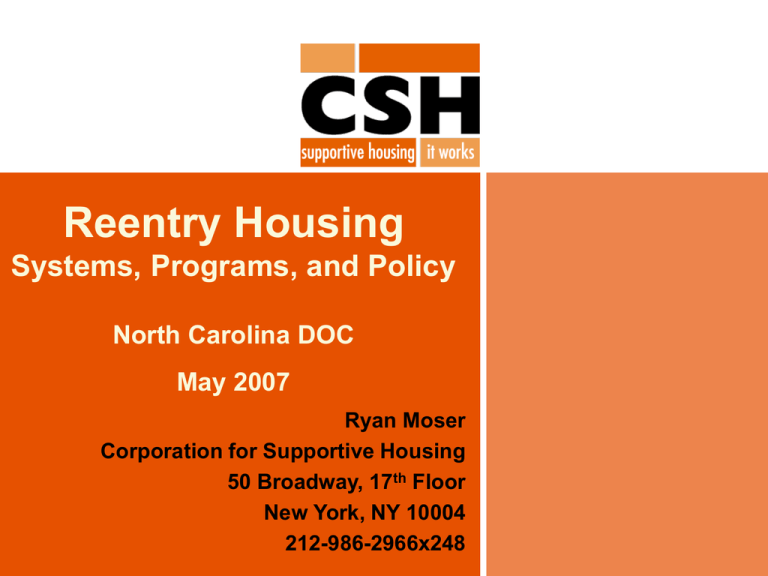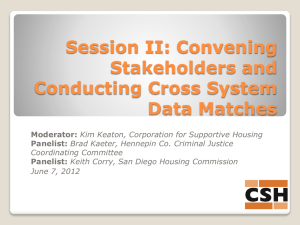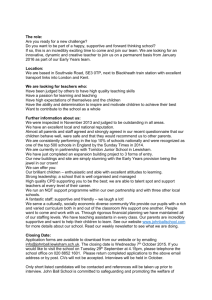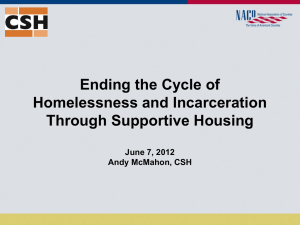Housing the Criminally Mentally Ill Offender
advertisement

Reentry Housing Systems, Programs, and Policy North Carolina DOC May 2007 Ryan Moser Corporation for Supportive Housing 50 Broadway, 17th Floor New York, NY 10004 212-986-2966x248 Reentry in Perspective Approx. 2.1 million individuals are incarcerated in total in the U.S. – 1.3 million in state and federal prisons – Another 750,000 are incarcerated or detained each day in local and county jails. Approximately 670,000 individuals are released from State and Federal prisons each year; that is about 1,840 releases every day. This does not include jails, roughly four times as many people are released from jails daily. Nationally, about 54% of homeless persons in shelter report previous incarceration – 49% report previous time in jail – 18% report previous time in prison Incarceration Rates in CSH States CSH State Populations Rate of Incarceration (per 1000) Convicted in Custody Held in Jail Released in 2004 Texas 976 171,338 66,534 65,800 California 682 166,532 82,138 117,762 Michigan 663 49,014 18,118 13,723 Maryland 636 23,276 12,386 10,531 Ohio 559 44,976 19,853 28,170 Connecticut 544 19,744 No Jail 6,707 New Jersey 532 28,124 17,621 14,418 Illinois 507 44,669 20,066 38,646 New York 482 62,963 29,535 26,043 North Carolina 620 53,854 17,171 9,315 Rhode Island 313 3,639 No Jail 828 Minnesota 300 9,187 7,023 5,849 Total Sentenced 738 1,512,823 747,529 672,202 *Over 50% of the correctional population in New York is released into the greater New York City area. *In 2006, 103,813 individuals were admitted to NYC DOC facilities with an average daily population of 13,497. Service Needs of Incarcerated Populations Homelessness – 10% are Homeless upon entry. Substance Use – 83% of State and Federal prisoners had histories of drug use and that 57% of them were using in the last month before their offense. Mental Illness – – – – 22% MI (NAEH, CSG) 16% are MI per DOJ (1999) 6% male SPMI, 12% SPMI Female (CCJ) ½ - ¾ of all Inmates Report MI Symptoms Service Needs of Incarcerated Populations, Continued Educational attainment – 46% of jail inmates report not having completed high school – 13.1% completed only 8th grade or less Foster care involvement – 11.5% of jail inmates had lived in a foster home, agency, or institution Familial status/factors – About 70% of women in local jails have young children – 46.3% of jail inmates had a family member incarcerated – 10.9% of jail inmates report being physically or sexually abused prior to age of 18; 20.2% for female inmates – 31% of inmates grew up with parental drug or alcohol use What are the Barriers at Release? No identification, SSI, birth certificate No disability determination Definitions of homelessness can exclude people coming from correctional settings No access to health or mental health services (excepting emergency care) Parole or Probation regulations- high risk of technical violations Lack of affordable housing resources and access issues Limited income Legal and illegal discrimination (criminal record, mental illness, substance use, homelessness, poverty, race) Post traumatic stress disorder, difficulty reintegrating Family reunification issues, particularly for women Variation: Setting and Individual Psychological Environment Threat of Danger Hyper-Vigilant Trust as Liability Physical Environment Jail Urban Rural Social Environment Housing General Population Protective Custody Administrative Segregation Special Housing Units Mental Health Wards DOC’s rules and regulations Inmate Code Racial/Ethnic associations Urban/Rural differences Gangs/Organizations SPMI Character Disorder Substance Use Prison Maximum Medium Minimum Trauma History Gender Learning Disability The Intersection of Mental Health and Corrections Mental Health and Correctional Trends Since 1970 1,600,000 1,400,000 Number in Institution 1,200,000 Persons Receiving Treatment in the State Hospitals 1,000,000 Persons Receiving Treatment in the Private Hospitals Persons Receiving Psych Care in Gen Hosp 800,000 Persons in Custody in Jail 600,000 Persons in Custody in Prison 400,000 200,000 0 1970 1976 1980 1986 1990 Year 1998 2000 2004 Breaking Down the Reentry Population to Target Effectively Low Need Individuals who are able-bodied and employable, who face an income/affordability gap; also may need short-term assistance with community reintegration Moderate Need Individuals with limited employment history and educational achievement, and who may have substance abuse, health or mental health challenges Frequent cyclers often fall in this category High Need Individuals with disabilities such as serious mental illness and chronic health and substance abuse issues who will need longer-term services Potential Residential Outplacements Post-Incarceration Permanent Housing Market Affordable Public Housing/Rental Assistance Service Enriched Permanent Supportive Transitional Housing Jail Homelessness Treatment Street Bridge Rental Assistance Unsuitable Housing ¾, ½ Housing Shelter Transitional Program Emergency Setting Emergency Housing Safe Haven The Cost of the Status Quo Culhane, Metraux and Hadley (2003) documented that supportive housing tenants each used an average of $40,000 per year in public emergency systems Individuals cycle between jails, shelters, emergency rooms, and services at high costs (Gladwell’s “Million Dollar Murray,” 2006) In 1982, national spending on law enforcement was less than $36 billion. This increased 417% ($185.5 billion) by 2003. This would support 10.3 million units of supportive housing annually. Reinvestment Client Profile: Incarcerated with SPMI 3758 days of hospital over 21 years @ $400/day = $1,503,200 399 days of jail time over 6 years @ $70 a day = $27,930 $1,531,130 = Total Cost $72,910 = Annual Cost *Does not include private hospital, treatment, court or arrest costs. The Good News: There are Alternatives Aligning Systems through Supportive Housing Criminal Justice Fractured Systems Housing Aligning Resources to Create Reentry Supportive Housing Focus on people who are inappropriately or overly incarcerated or institutionalized: – – – – (Homeless) parolees with high risk of violation Frequent flyers Street homeless individuals with active substance use Mentally ill individuals that could benefit from an alternative to incarceration Determine cost associated with preventable prison, jail, and other systems use Structure housing and services initiative with projected recidivism reduction target Obtain private funding to “prime the pump” and achieve initial savings Invest savings into housing (i.e. operating and services) Aligning Multiple Systems for Better Results Criminal Justice Housing HUD Shelter + Care Public Housing Authorities Section 8 NYS DOC Social Services NYC DOC Shelter Plus Care PROBATION NY/NY III Service Contracting through Criminal Justice/Human Service Agencies PAROLE Bridge Rental Support Client Identification Transitional Case Management Health and Behavioral Health Mental Health Support Services Housing Support ACT Teams Supportive Housing Employment Employment Initiatives both Federal and Local Cost Savings Potential for Parole Violators in NY On average, parole violations result in 120 day prison stays (0.45 years) Preventing violations for 200-250 individuals would reduce state prison bed needs by 90-100 beds Closing prison facility of 100 beds would save $2.5-6 million that could be reinvested into a capitalized operating and service fund for supportive housing How is Supportive Housing Financed and Targeted? Funded through blend of sources: – Capital - Low to no-debt permanent financing & tax credit equity – Operating – Rental assistance or operating contracts (Section 8, Shelter Plus Care, etc.) – Services – Contract or fee-for-service revenues from various human service agencies/programs Operating and services funding drives eligibility and targeting of units (e.g. mental health, HIV/AIDS, etc.) There are no dedicated operating and services funding streams for parolees, and many are ineligible for existing streams/housing Integrating Corrections with Supportive Housing Provide bridge rental assistance for returning inmates during “re-entry” phase (e.g. parole term) Fund prison- or jail-based “in-reach” services to assess, recruit and facilitate referrals to supportive housing Enhance case management services in existing units of supportive housing Capitalize operating and social services reserves to “buy” set-aside units for re-entering individuals in new mixed tenancy supportive housing developments The Fortune Society’s Fortune Academy (The “Castle”) Emergency and Transitional (Phase-Permanent) Targeted tenancy: Formerly incarcerated men and women, some people living with HIV/AIDS Model: Emergency housing (18 beds) and Phase-Permanent Supportive Housing (41 units) Funding: – Capital: HHAP grant, LIHTC, Historic Tax Credits – Operating: HOPWA, HUD SHP – Services: HOPWA, existing agency services Project Renewal, Parole Support and Treatment Program Transitional with Mental Health and Chemical Dependency Focus Targeted tenancy: 50 individuals with mental illness and substance use issues released from state prison with a minimum of a one-year parole obligation Model: Transitional (2-year), scattered-site, 50 units Funding: – Capital: None – Operating and Services: • OMH Supported Housing • DOJ Byrne discretionary grant via NYS Parole The Doe Fund, Ready Willing and Able Transitional with Employment Focus Targeted tenancy: Formerly incarcerated men in recovery, committed to sobriety, self-help through employment and transition to independent living Model: Transitional (912months), 470+ units Funding: – Capital: HPD – Operating and Services: • DHS • HUD McKinney-Vento Supportive Housing Program • Earned Revenues • Private Sources • DOJ Byrne Discretionary Grant St. Leonard’s House’s St. Andrew’s Court Emergency and Permanent Targeted tenancy: Homeless men with histories of incarceration, leaving emergency housing Model: Supportive housing, 42 studio apartments Funding: – Capital: Illinois Housing Development Authority grant, 9% tax credits, FHLB AHP – Operating/Social Services: HUD McKinney Shelter Plus Care, IL DOC contract The Bridge, Inc.’s Iyana House Permanent with Mental Health Focus Targeted tenancy: Women released from state prison on parole with serious mental illness and histories of homelessness Model: Permanent supportive housing with intensive supports; 18 studios Funding: – Capital: NYS Office of Mental Health bond financing – Operating: HUD McKinneyVento Supportive Housing Program – Services: NYS Office of Mental Health net deficit financing Heritage Health and Housing’s MIX Program Emergency and Permanent with Mental Health Focus Targeted tenancy: Parolees with SPMI Model: Transitional “Safe Space” (6 beds) and Scattered-site Supportive Housing (18 apartments) Funding: – Capital: None – Operating/Services: HUD SHP (Transitional) and NYS OMH Supported Housing (Scattered-site) Challenges for Reentry Housing Service Providers and Those Who Work with Them •Criminal-justice-involved Individuals (CJI) can be difficult to engage during incarceration and difficult to find after release. •Prepare providers for intensive recruitment including consistent contact through placement and jail or prison in-reach. •CJI are at a high risk of recidivism during from identification through the first 90 days of placement. •Encourage providers to dedicate staff and plan for high levels of client support during this critical time period. •CJI may be distrusting of providers and try to manipulate their services. •Help providers develop cultural competence and effective engagement techniques for this population. •CJI may have undiagnosed or untreated mental and other health needs. •Encourage providers to connect with support services and develop staff for MH assessment. •CJI may have complicated systems usage. •Ensure providers are well versed in navigating public benefits and health systems. •CJI face specific additional employment barriers. •Build provider knowledge about reentry employment strategies. •CJI may face ongoing criminal justice compliance requirements. •Help providers build knowledge about criminal justice procedures and policies. •CJI may be ineligible for particular types of subsidies and funding or may face other restrictions that interfere with successful placement. •Help providers build capacity with community outreach and NIMBY concerns as well as facility with challenging perceived barriers where possible and appropriate. The NYC Frequent Users of Jail & Shelter Initiative Overview Initiative Background The Frequent User Initiative emerged through ongoing DOC/DHS collaboration to improve discharge planning services in City jails Decision to focus on shared population that represents high needs and high cost: – People who are chronically homeless and who cycle frequently and regularly between jails and shelters Demonstration program intended to: – Develop and refine an intervention in practice – Determine whether supportive housing with enhanced services can break the cycle of homelessness and incarceration among frequent users – Provide basis for larger-scale replication Prior Research on High / Frequent Users Hopper et. al. (1997) found that long-term homeless persons with severe mental illness experienced an “institutional circuit” that includes shelters, jails, ED, detox Kuhn and Culhane (1998) found that approximately 10% of shelter users in New York City were ‘episodic’ users of shelter – These individuals are “more likely to be non-White, and to have mental health, substance abuse, and medical problems.” – “Much of the periods they spend outside of shelter may be spent in hospitals, jails, detoxification centers, or on the street. Indeed, one could argue that part of the very reason that these individuals do not become chronically homeless or long-term shelter residents is their frequent exit to inpatient treatment programs, detoxification services, or to penal institutions. Nevertheless, these clients often find their way back to shelters.” Culhane et. al. (2002) found that homeless persons with serious mental illness cost $41,000 annually through usage of emergency public systems Ford (2005) identified 61 frequent flyers of a FL county jail, of whom 82% were homeless,100% had substance abuse history, and 51% had a mental health history Gladwell (2006) described individual who cost roughly $1 million in public service utilization New York City’s Frequent Users of Jail and Shelter Target population Approximately 850 individuals at any point in time that have at least 4 jail stays and 4 shelter stays over the past five years These individuals cycle constantly and persistently with relatively short stays per episode The following figure illustrates an extreme case of jail-shelter cycling over a two-year period: Frequent User Case Study 21-Feb-01 9-Mar-01 22-Mar-01 14-Jun-01 18-Jun-01 DHS DOC DHS DOC DHS 31-Dec-02 3-Feb-01 DOC 2-Aug-02 26-Jan-01 Neither System DHS 8-Apr-02 15-Jan-01 DOC DOC 5-Apr-02 1-Jan-01 DHS DOC 9-Mar-02 DHS 8-Mar-02 DOC 21-Dec-01 DHS 12-Nov-01 DOC 16-Oct-01 DHS 7-Sep-01 DOC 4-Aug-01 DHS 23-Jul-01 DOC 17-Jul-01 DHS Characteristics & Service Needs of Jail-Shelter Frequent Users Believed to have high rates of co-occurring and complex issues: – Alcohol and substance use (approx. 80%); earlier data matches found high utilization of crisis drug treatment services (i.e. Medicaid-reimbursed detox) – Mental health issues (est. 30-50%), including serious mental illnesses (est. 25-40%) Criminal offenses largely consists of low-level misdemeanors (i.e. “quality of life” crimes), with minor felony histories Histories of transience and high level of involvement in multiple systems and services Providers report: – Lack of trust in service providers and inconsistent benefits enrollment – Comparatively high occurrence of behavioral issues and lower degrees of independent living skills – Individuals are difficult to keep in one place and need nearly constant handholding as they navigate systems involvement Research Suggests that Housing with Services Can Break the Cycle Intensive service models such as Assertive Community Treatment or Intensive Case Management reduce recidivism to local corrections (Lurigio et. al., 2000; Ventura et. al, 1998; Hartwell and Orr, 1999; Lamberti et. al, 2004.) Recidivism and homelessness among persons with serious mental illness is higher among individuals with social disadvantage (poverty, lack of education, etc.) – Suggests that economic supports such as housing and employment services are as important as mental health treatment and case management services (Draine et. al., 2002) Supportive housing significantly reduces involvement in jails and prisons (along with shelter, hospitals, etc.) among homeless persons with serious mental illness (Culhane et. al., 2002) Resources and Models 50 NYCHA Section 8 vouchers (Project Based) 38 NY/NY I and II supportive housing unit set-asides 12 DHS SRO Support Subsidy-funded supportive housing unit set-asides Supportive services funded through other existing sources (e.g. COBRA, HUD) $650,000 from JEHT Foundation for service enhancements A. 50 Single-site (Congregate) supportive housing with frontloaded intensive services B. 50 Scattered-site supportive housing with front-loaded intensive services --------------------------------------------Total: 100 units of supportive housing with FUSE Frequent User Services Enhancements (FUSE) Supplemental funding to enhance services attached to unit during first year of tenancy in housing Uses include client engagement/recruitment, intensive case management, clinical supervision, and additional specialty services Can be used to lower client-to-case manager ratios, or fund dedicated FUSE service staff to provide intensive support during first year of housing Grant from the JEHT Foundation provided FUSE in the amount of $6,500 per unit Recruitment/ Placement Stabilization Declining Intensity Continuing Tenancy $13,500 $13,500 $13,500 $13,500 $13,500 $13,500 25 26 27 28 29 30 $13,500 $13,500 24 $13,500 21 $13,500 $13,500 20 23 $13,500 19 $13,500 $13,500 18 22 $13,500 17 $13,500 13 $13,500 $13,500 12 16 $13,500 11 $13,500 $13,500 10 15 $13,500 9 $13,500 $6,500 $13,500 8 14 $6,500 $13,500 7 $3,000 $4,000 $5,000 $6,000 $6,500 $6,500 $6,500 $6,500 $13,500 $6,500 $2 0, 00 0 6 $1 5, 00 0 $13,500 $6,000 $4,500 $3,000 $1 0, 00 0 5 4 3 2 $1,000 $0 1 $0 $5 ,0 00 $2 5, 00 0 Sample FUSE Funding Phase Chart (12 unit program) FUSE Existing (Baseline) Services In-reach, recruitment, and engagement Participating providers are responsible for conducting in-reach and recruitment of frequent user clients Client recruitment can take place in one of two ways: – Shelter match-up: Providers conduct in-reach into shelters where frequent users are found in large numbers, DHS facilitates coordination with shelter operator/staff – Jail-based recruitment: Providers participate in routine in-reach sessions in jail facilities, must be able to attend to temporary housing needs if housing is not ready upon release Providers interview clients in jail, shelter, or on-site Providers conduct or arrange for psychosocial assessment and completion of housing applications Providers assist clients with benefits connections and resolution of eligibility restrictions Model A: Single-Site with FrontLoaded Intensive Services Congregate style housing situations range from single room occupancy and shared apartments to private studios Providers use service enhancements to: – Identify clients through jail and shelter in-reach, or from their own programs – Provide pre-placement stabilization and assistance in completing housing packets – Give intensive support and case management during transition and during the first year following placement after service intensity is reduced to a more typical level of services On-site services include mental health services, independent living skills, and intensive case management Recreation and support groups provide additional support to supplement staffing and build community Existing units allow for expedited placement after initial client interviews are complete Model B: Scattered-Site with FrontLoaded Intensive Services Scatter-site housing situations are market-rate apartments masterleased by the provider; one model uses single rooms in a shared home Providers use service enhancements to: – Identify clients through jail and shelter in-reach, or from their own programs – Assist with Section 8 applications and provide intensive case management services before placement – Give intensive support during transitions and throughout a critical time period following placement – Provide additional support through peer mentors Case management services are provided through other agency programs, generally in close proximity to the housing units Service enhancement helps reduce caseloads for more intensive case management before and after placement Initiative Partners Administration and Program NYC DOC and DHS – oversight, identification of target population, troubleshooting CSH – administer service enhancement funding, assist with recruitment, oversight, training and TA John Jay College – process and outcomes evaluation Nine non-profit service providers – provide direct housing assistance to 100 individuals Funding and Policy NYC Housing Authority – provide vouchers and manage approval process NYC DOHMH and DHS – funds supportive services and operating funding for single-site units JEHT Foundation – funding service enhancements NYC HRA – public assistance and approvals for NY/NY I and II units NYC OMB – oversight, policy Monitoring, Oversight, and Evaluation Monthly meetings with nine providers, DOC, DHS, CSH, and John Jay Tracking provider progress in achieving program benchmarks – Recruitment – Placements – Service contacts Participation in evaluation is required of participating providers Formal program evaluation measures: – Housing stability/retention – Reduction in jail and shelter use in days – Time between returns to jail/shelter Training and technical assistance DOC, DHS, and CSH also provide technical assistance and troubleshooting around client recruitment, engagement, services delivery, administration of housing, etc. CSH is also organizing and funding trainings for providers around: – Understanding needs of forensic individuals (SPECTRM) – Successfully Housing People with Substance Use Issues Early Lessons “In-reach” and upfront engagement and of individuals prior to placement is key to successful placement – Shift in provider practice required from passive tenant selection to active recruitment Clients’ involvement in multiple systems increases need for cooperation of multiple agencies, systems, and stakeholders to achieve success and reduce recidivism – “Systems” level troubleshooting is key Reentry Housing Systems, Programs, and Policy North Carolina DOC May 2007 Ryan Moser Corporation for Supportive Housing 50 Broadway, 17th Floor New York, NY 10004 212-986-2966x248





